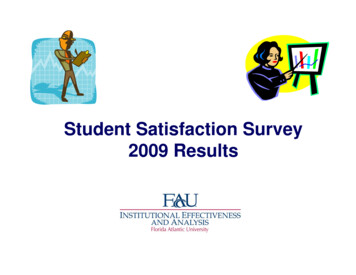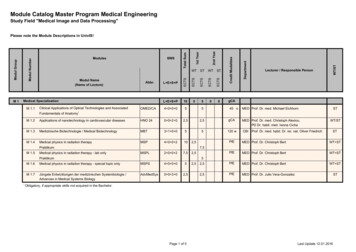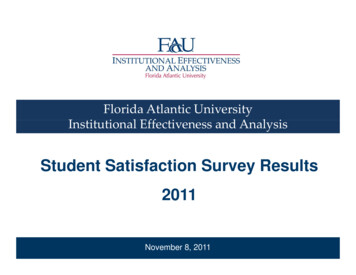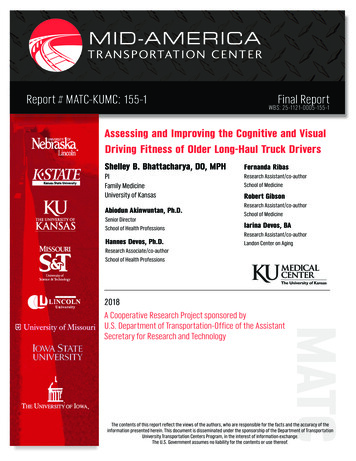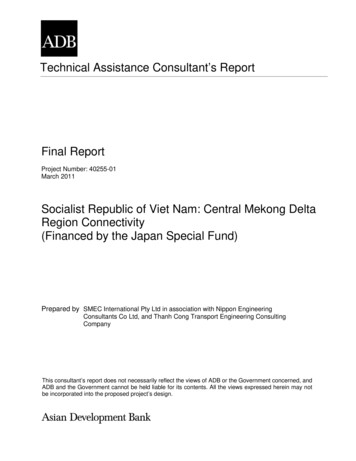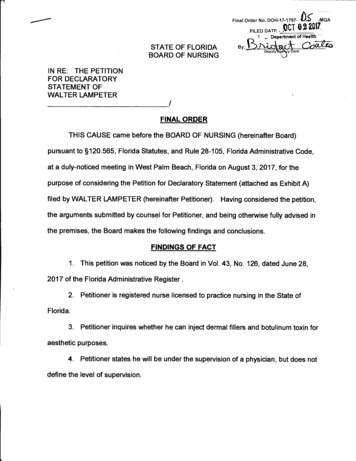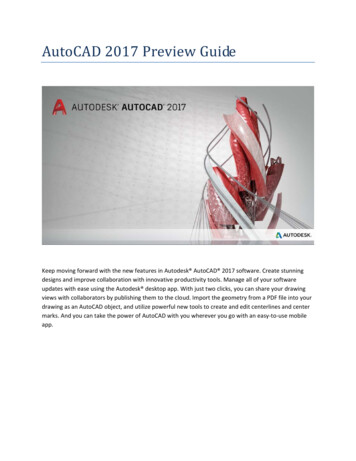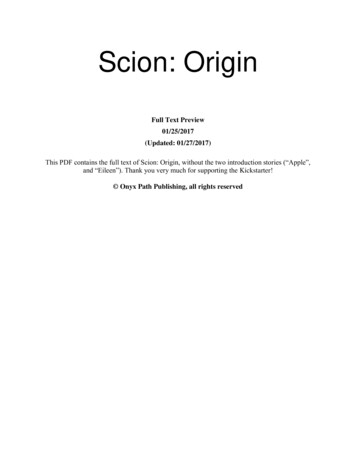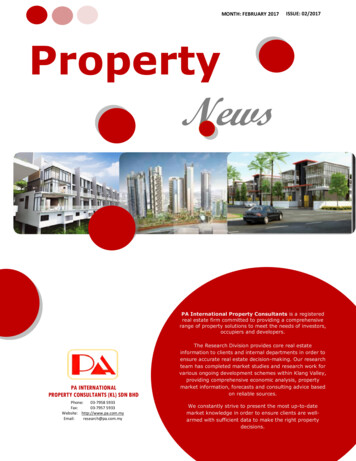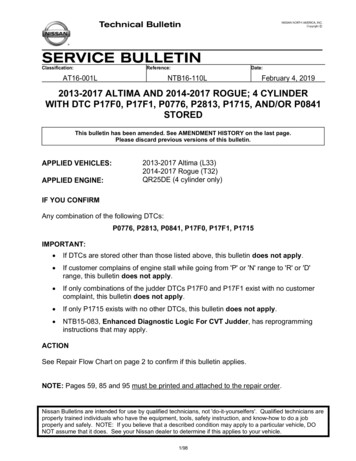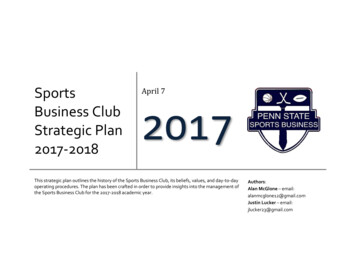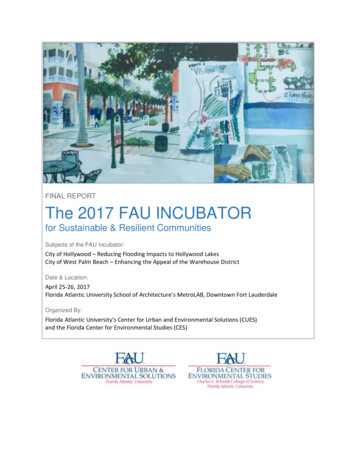
Transcription
FINAL REPORTThe 2017 FAU INCUBATORfor Sustainable & Resilient CommunitiesSubjects of the FAU Incubator:City of Hollywood – Reducing Flooding Impacts to Hollywood LakesCity of West Palm Beach – Enhancing the Appeal of the Warehouse DistrictDate & Location:April 25-26, 2017Florida Atlantic University School of Architecture’s MetroLAB, Downtown Fort LauderdaleOrganized By:Florida Atlantic University’s Center for Urban and Environmental Solutions (CUES)and the Florida Center for Environmental Studies (CES)
THE FAU INCUBATOR PROCESSResilience is the ability to prosper through adversity, andsustainability is fostering development that promoteseconomic growth, environmental stewardship and socialequity. The Florida Atlantic University (FAU) Incubator forSustainable & Resilient Communities is a communityengagement activity designed to foster coastal resilienceand livable communities in South Florida. This includesadapting aging infrastructure to rising ocean levels,creating safe streets, increasing mobility fordable housing, and creating vibrant public spaces.FAU’s objective is to convene structured brainstormingsessions with local officials that yield actionable solutions.The cities of Hollywood and West Palm Beach participatedin the inaugural FAU Incubator for Sustainable & ResilientCommunities on April 25-26, 2017, each with distinctconcerns in the study areas they identified. The city ofHollywood sought strategies for the Hollywood Lakescommunity, where increased flooding requires updatedinfrastructure and creative financing solutions. The city ofWest Palm Beach focused on the Warehouse District, anarea under redevelopment that could benefit fromexamining the zoning code and improving walkability andtransit connectivity to other key destinations.To address these issues, FAU assembled a team of expertsfrom a variety of backgrounds in the public and privatesectors to lend expertise and fresh perspectives. After sitevisits and presentations, participants gathered at FAUSchool of Architecture’s MetroLAB in Downtown FortLauderdale to draw upon the group’s collectiveknowledge and experience to identify options andimplementation strategies.Onsite in West Palm BeachOnsite in HollywoodAt FAU MetroLAB in Fort LauderdaleOUTCOMESDuring the event, elected officials and city staff had the opportunity to network, ask questions and discusstheir concerns in the areas of planning, resilience and sustainability with peers from other cities, experts fromrelated fields, as well as private developers. This report describes the study areas and contains a list of shortand long-term recommended actions and strategies for each city, as well as additional planning resources.Full details appear in the body of this report.Page 2 of 18
Incubator highlights include, for the city of Hollywood’s growing flooding challenge, integrating a livingshoreline with existing seawall networks. This solution appears likely to mitigate current short-term impacts.Putting longer-term strategies in place will require first building consensus among stakeholders and exploringinnovative financing options, such as a public-private partnership, or a special-benefit taxing district.In West Palm Beach, a vision for the Warehouse District’s future should be crafted with public and privatepartners providing input so that zoning options, financing tools and economic development strategies can beexplored and implemented. Specifically, the creation of an overlay zoning district was encouraged along witha Business Improvement District to assist with infrastructure, placemaking and programming to promote newdevelopment, parking and mobility solutions, enhanced public spaces, and the promotion of arts and events.The group also encouraged the city to explore an innovation district concept where private industry,government, nonprofit organizations and local universities, including Florida Atlantic University could partnerto bolster the Warehouse District as an innovation hub.By having the staff from the cities of Hollywood and West Palm Beach together in conversation at theIncubator, common themes around implementation and planning emerged. Despite facing differentchallenges, both groups benefitted from the each other’s experience and discussing the process of engagingstakeholders to develop a vision and actionable steps towards implementation. They each benefited fromthe resource experts in the room and were able to make suggestions based on common issues that facemunicipal governments.All participants, moderators and experts involved in the Incubator benefitted from examining the problemsfaced by Hollywood and West Palm Beach. Many cities across South Florida and other coastal regions couldlearn from this experience. Coastal municipalities are on the frontlines of climate change and are beginningto experience the impacts of sea-level rise. They can benefit from experts that can identify and suggest shortand long-term solutions. Moreover, at the same time these cities are trying to revitalize neighborhoods andencourage growth and development in a sustainable and resilient manner. The FAU Incubator for Sustainableand Resilient Communities provides the forum for stakeholders to engage with experts across the public,private and academic sectors to identify solutions summarized in this report. Most of the suggestions wouldbe applicable to many other communities facing similar challenges.ABOUT THE INCUBATORA partnership between FAU’s Center for Urban & Environmental Solutions and the Florida Center forEnvironmental Studies, the FAU Incubator for Sustainable & Resilient Communities is a forum forstakeholders and decision-makers to develop action plans that address complex land use andinfrastructure problems. The Incubator offers leadership and expertise based on best practices andprovides guidance on developing implementable plans and policies.FOR MORE INFORMATION – PLEASE CONTACTJohn Renne, PhD, AICPColin Polsky, PhDMaryBeth HartmanSerena edushoermann@fau.edu(561) 297-4281(954) 236-1104(954) 236-1203(561) 297-4167Page 3 of 18
Forward from Mayor Levy, City of Hollywood, FloridaStanding in a neighborhood street, knee deep in saltwater ona sunny day during a King Tide, it is clear that sea level rise is apressing issues facing Hollywood. When I was elected asMayor in 2016 I knew sea level rise and associated flooding,both current and projected, would offer me challenges toovercome for the City. More than just problems to solvehowever, the challenges faced by today’s coastal cities alsoprovide unparalleled opportunity to redefine our communityand create a Hollywood that is resilient, sustainable, anddesirable now and into the future.One of the greatest opportunities of sea level rise is that itcannot be tackled completely in isolation. Certainly, the Cityhas taken and will continue to take steps to improveinfrastructure and relieve some of the burden felt by flooding, but a global and regional problem requiresglobal and regional action. Recently, I joined with other Mayors across the country to reaffirm ourcommitment to addressing the causes of climate change and its impacts, like sea level rise, head on. TheCity is also extremely fortunate to be in a region that is rife with opportunities for collaboration to developregional tools and approaches. Florida Atlantic University has been an invaluable partner in this effort.The 2017 Florida Atlantic University Incubator for Sustainable and Resilient Communities allowed us tofocus in on one neighborhood on the front lines of sea level rise and develop ideas that do so much morethan simply solve a problem. The suggestions resulting from the Incubator not only will help alleviate theburden of flooding, but they do so while at the same time addressing other areas that are important fora sustainable and resilient community. The solutions enhance the natural environment and environmentalquality, incorporate mobility, increase economic opportunity, and create value that will benefit the entireCity, not just the neighborhood in question. This is the way to create sustainability and resiliency. We mustdo more than simply solve problems, we must use those problems as opportunities for making our Cityeven better.We want to offer many thanks to Florida Atlantic University and the panel of experts they organized togive our City’s challenges a fresh perspective. Only through collaboration and openness to different waysof doing things will we be able to move forward better and stronger than we were before.Page 4 of 18
Forward from Mayor Muoio, City of West Palm Beach, FloridaWhen I was first entered public service in the City of West PalmBeach in 2006, the challenges facing our community werepredictable. Education, public safety, and the economy werethe top three topics people were concerned about, as theyhistorically have been. Fast forward to 2017, and the conceptof what makes a city a great place to live has expanded.Creating cities where people want to live, work and play meansaddressing tough issues that are far from predictable.Now, city leadership must look at an array dynamics affectingthe daily experience of our residents. Cities are at the forefrontof innovation, addressing equity, and leading environmentalsustainability. Each and every day, we have the most to gainand the most to lose while facing these challenges. Cities arecreating best practices, sharing these ideas and fine tuning them with local academic leaders and othercity leaders.Florida Atlantic University’s 2017 Incubator for Sustainable and Resilient Communities addressed twoexamples of the new normal facing cities in South Florida. First, a city must grow all segments of itscommunity in new ways that create equitable opportunities for not only existing industries but alsoresidents. An Innovation Hub is one way to address that need. Second is Climate Change. We now knowclimate change is real. Communities, specifically those on the coast, are considering all strategies forhandling sea level rise and other climate related challenges. Cities are leading the way in to a sustainableand resilient future.We do not have the convenience of time to debate these matters. Each year the tides get higher and ourjob demands grow, which is why opportunities to work with universities and with other cities are criticalto our future.I want to thank Florida Atlantic University and the City of Hollywood for working with the City of WestPalm Beach to further invest in developing solutions for these challenges.Page 5 of 18
FAU INCUBATOR PARTICIPANTSCity of HollywoodMayor Josh Levy, City of HollywoodCommissioner Debra Case (Dist. 1), City of HollywoodLorie Mertens-Black, Chief Civic Affairs Officer, City of HollywoodLindsey Nieratka, Environmental Sustainability Coordinator, City of HollywoodArceli Redila, Planning & Development Services Administer, City of HollywoodFrank Leon, Engineer, City of HollywoodCity of West Palm BeachMayor Jeri Muoio, City of West Palm BeachChristopher Roog, Director of Economic Development, City of West Palm BeachScott Kelly, Administrator, City of West Palm BeachRick Greene, Director of Development, City of West Palm BeachWill Earl, VP of Development, The Warehouse DistrictE. Hunter Beebe, Managing Principal, Healthcare Real Estate CapitalExpertsMichael Busha, Executive Director, Treasure Coast Regional Planning CouncilNader Salour, President, Cypress RealtyTim Hernandez, Principal, New Urban CommunitiesRaphael Clemente, Executive Director, Downtown Development Authority, Downtown West Palm BeachBilly Fields, Assistant Professor of Political Science, Texas State UniversitySusan Coughanour, Board of Directors, Palm Beach County Planning CongressKim Briesemeister, Principal Redevelopment Management Associates (RMA)Jeff Huber, Assistant Professor, Florida Atlantic UniversityRicardo Alvarez, President, Mitigat.comNancy Gassman, Assistant Public Works Director, Sustainability Division, City of Fort LauderdaleMitch Chester, Attorney, Law Office of Mitchell A. Chester, P.A.Francis Lyn, Director, MetroLAB Collaborative, Associate Professor, Florida Atlantic UniversityKevin Fischer, Senior Planner, Palm Beach County MPOFlorida Atlantic University (FAU) HostTony Abbate, Associate Provost Broward Campuses, FAUFAU Conveners/FacilitatorsDr. John Renne, Director & Associate Professor, FAU Center for Urban & Environmental Solutions (CUES)Dr. Colin Polsky, Director & Professor, FAU Center for Environmental Studies (CES)FAU StaffMaryBeth Hartman, Conference & Outreach Coordinator, CESAlana Edwards, Education and Training Coordinator, CESSerena Ann Hoermann, Florida Climate Institute Coordinator, CESPage 6 of 18
CITY OF HOLLYWOOD, FLORIDALike many communities in South Florida, the city of Hollywood is impacted by flooding. 1 As BrowardCounty Assistant Public Works Director Nancy Gassman noted, “In 2015 the tide rose one foot abovepredicted levels, exacerbated by the passage of a tropical storm and an anomaly in the Gulf Stream”.2 TheSoutheast Florida Regional Climate Compact projects even greater impacts in the near future.3 During asite visit to the study area, the Mayor of Hollywood Josh Levy and Commissioner Debra Case indicatedwhere flooding limits access to properties, and residents described how saltwater encroaches on theirproperties and ruins their vehicles’ brakes.The Hollywood project study area (Figure 1) included District 1 Boundaries, which begin at the intersectionof Federal Highway and Pembroke Road, then northerly on Federal Highway to Sheridan Street, thenFigure 1 City of Hollywood Study Area (see Figure 2 for enlargement area)1See Mayor Josh Levy’s video of the September 2016 King Tide impacts to the city, https://youtu.be/7IM-vDX-Zf82Learn about the connection between rising temperatures and the Gulf ially-direconsequences/?utm term .6fdd395e45213SE Florida Regional Climate Compact Indicators, cators/Page 7 of 18
easterly along Sheridan Street and the city's corporate boundary to the Atlantic Ocean, then southerly tothe city's corporate boundary, then westerly to the Intracoastal Waterway, then northerly to PembrokeRoad, then westerly on Pembroke Road to Federal Highway.The Incubator team focused primarily on a section of the Hollywood Lakes neighborhood (Figure 2), whichis part of District 1. Some recommendations apply to the larger study area, others specifically toHollywood Lakes, and some may have implications for other sites in the city or other communities.Experts at the Southeast Florida Regional Climate Change Compact’s workshop, Resilient Redesign II,summarized the residential area of Hollywood Lakes as follows:4“Several iterations of redevelopment have occurred in the community In many cases, propertyredevelopment did not necessarily result in the reconstruction of seawalls or placement ofadditional fill material to raise the property, leading to the current conditions of temporaryflooding along waterfront boundaries in response to high tides and elevated groundwater levels.In order to counteract flooding, the city and its residents are implementing temporary site-specificsolutions.”The site’s flood protection and drainage infrastructure are in need of retrofitting, and overall, thecommunity needs to implement a resilience and adaptation strategy that will sustain the waterfrontcommunity with limited resources.Figure 2 Hollywood Lakes area (circled in blue on Figure 1 map)City officials sought FAU Incubator assistance on a number of issues related to the Hollywood Lakes studyarea, and their top concerns were: Flooding and the need to update infrastructureAs in other coastal urban areas, waterfront property and transportation infrastructure are subjectSee the full Resilient Redesign II Hollywood solutions presentation given by Jennifer Jurado at the 7th Annual SEFlorida Regional Climate Leadership Summit.4Page 8 of 18
to, or at risk of, flooding as a result of rain events, extreme high tide events, storm surge and sealevel rise.Exploring financing optionsStudies and outreach activities have revealed next steps the city would like to take, but movingsome projects forward has proven challenging.CITY OF HOLLYWOOD - ACTION ITEMSOn Day One, city officials and FAU’s team of expertsparticipated in site visits and discussion about the concernsidentified above. On Day Two the group met for a facilitatedbrainstorming session at FAU School of Architecture’sMetroLAB in Downtown Fort Lauderdale. They focused onidentifying options and implementation strategies in the areasof information gathering, infrastructure, financing and gainingpolitical support. The discussion included wide-rangingobservations and suggestions reflecting the diversebackground of the participants.Data collection stepsBefore infrastructure improvements can be implemented, the following data will be needed: Inventory the existing seawalls.Ascertaining the dates and type of construction, and present condition will be key, as someexisting “seawalls” are actually bulkheads and some viewed on the site visit appeared unable tostructurally withstand the pressure of flowing water. The county is doing a study to set aminimum height. Collect good information on soils.Soil permeability will inform choices of infrastructure adaptation. For example, limestone orpeat are more permeable and allow absorption of rainfall. Information can be obtained from thecity in the building permit data. Identify demonstration projects to implement.Infrastructure strategiesStrategies to address flooding and saltwater inundation along the waterfront road between homes andthe Intracoastal Waterway: Create a hybrid living shoreline extending into the water.The city owns the right-of-way between homes and waterway - land adjacent to homes and firstfive feet - and the docks are leased by homeowner from the city. The rear alleyway could allowaccess to homes, while the roadway in front of homes could be returned from impervioussurfaces to a natural state. The city of Hollywood could re-issue residents’ dock permits with therequirement of maintenance of the seawall. Change landscape code to require salt tolerant plants.Page 9 of 18
Put in a landscape barrier behind the sea wall on the city’s property, and a knee wall built withflood doors to drop in and prevent water from coming in. As long as the doors are used, theknee wall would stop water, although it would restrict parking. Create a berm as a temporary solution to flooding, and the city can incorporate public use.Example – Las Olas Blvd, Fort Lauderdale. Plant trees to soak up water during inundation and take over the space. Mangroves might servethis function and signal to developers that the area is prone to flooding. To address flooding at the marina around Polk Street, raise either the boat ramp or the parkinglot, whichever is more affordable. Note, flooding also comes from behind as saltwater isbubbling up behind the seawall.Large scale infrastructure solutions: Create a hydric park with recreational features - a concept which works elsewhere. Extend public transportation (“Tan-Line”) connecting the beach with Downtown.Financing and Creating Political WillImplementation of strategies requires support fromstakeholders, as well as financial resources. Create an infrastructure task force so thatstakeholders will support suggested strategies. Establish a special improvement or benefit district –the cost of the infrastructure for flood protectionshould be charged to the property owners thatbenefit from this investment. Public Private Partnership - Offer a low-cost lease for a developer to create a marina on SouthLake with the requirement of a s
regional tools and approaches. Florida Atlantic University has been an invaluable partner in this effort. The 2017 Florida Atlantic University Incubator for Sustainable and Resilient Communities allowed us to focus in on one neighborhood on the front lines of sea level rise and develop ideas that do so much more than simply solve a problem.
